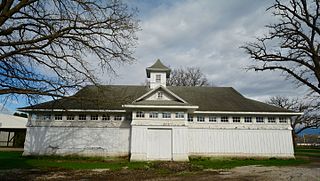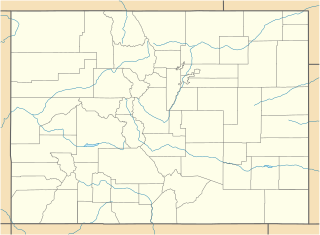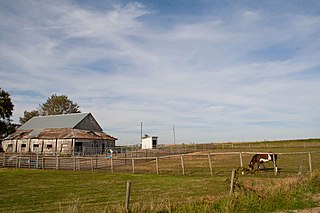
In the USSR, during the eleven-year period from the death of Joseph Stalin (1953) to the political ouster of Nikita Khrushchev (1964), the national politics were dominated by the Cold War, including the U.S.–USSR struggle for the global spread of their respective socio-economic systems and ideology, and the defense of hegemonic spheres of influence. Since the mid-1950s, despite the Communist Party of the Soviet Union (CPSU) having disowned Stalinism, the political culture of Stalinism—a very powerful General Secretary of the CPSU—remained in place, albeit weakened.
Roswell "Bob" Garst was an American farmer and seed company executive. He developed hybrid corn seed in 1930 that allowed greater crop yields than open-pollinated corn. He was perhaps most well known for hosting Nikita Khrushchev on his farm in Coon Rapids, Iowa, on September 23, 1959. He sold hybrid seed to the Soviet Union beginning in 1955 and played a role in improving US-Soviet communication.

The following are the Pulitzer Prizes for 1956.

The Roswell and Elizabeth Garst Farmstead Historic District is a farm in Guthrie County, Iowa, United States, near the city of Coon Rapids. It is significant as the home of farmer and hybrid corn populizer Roswell Garst. During the 1930s and 1940s, Garst played an active role in the conversion of old-style family farms to modern agribusiness. He was a key marketer of hybrid seed corn, which greatly increased corn yields per acre. Further, he espoused the use of nitrogen and other chemical fertilizers to renew soil so that fields need not be left fallow in order for the soil to replenish, allowing farmers to grow more acres of corn. Additionally, he embraced the use of cellulose from corncobs left after processing seed corn as cattle feed.
Whiterock Conservancy is a 501(c)(3) land trust located in west-central Iowa that stewards over 4,000 acres of contiguous land located in the Middle Raccoon River watershed, and an additional 1,000 non-contiguous land located in the Brushy and Middle Raccoon River watersheds. The Whiterock landscape almost exclusively made possible by an extraordinary planned land gift from the Garst family to Whiterock Conservancy. The landscape is a mosaic of agricultural land, wetlands, preserved prairie and oak savanna, riverine woodlands, and upland forest. The land is also home to the historic Roswell and Elizabeth Garst Farmstead, which hosted Soviet Premier Nikita Khrushchev in 1959, and is now on the National Register of Historic Places. The land is used for recreation, environmental conservation, and for the production of agricultural products, and is managed as a working landscape where cultural, environmental, agricultural, and recreational land uses are held in equal importance.

Powhatan Rural Historic District, formerly "Powhatan Plantation" and before that "Hopyard Plantation", is a national historic district located near King George, King George County, Virginia. It encompasses 15 contributing buildings, 1 contributing site, and 3 contributing structures in a rural area near King George. The district represents a significant reassemblage of the land holdings of Edward Thornton Tayloe, a member of the U.S. diplomatic service under Joel Roberts Poinsett, in the mid-19th century and one of Virginia's most affluent planters of that era; who inherited it from his father John Tayloe III, who built The Octagon House in Washington DC, and it was known then as 'Hopyard,' he inherited it from his father John Tayloe II who built the grand colonial estate Mount Airy. It contains three distinct historic residential farm clusters as well as two post-1950 stable complexes and several other auxiliary residential and agricultural buildings. The main house, known as Powhatan, is sited prominently on a ridge overlooking the Rappahannock River valley.

The Muscatine County Fairgrounds are located in West Liberty, Iowa, United States. It hosts the annual Muscatine County Fair. The Muscatine County Historic Preservation Commission received a grant from the State of Iowa to study the fairgrounds in 2014. Most of it was listed as a historic district on the National Register of Historic Places as the West Liberty Fairgrounds Historic District in 2015. At the time of its nomination it consisted of 42 resources, which included 16 contributing buildings, two contributing sites, two contributing structures, 16 non-contributing buildings, and six non-contributing structures. Historic tax credits will be used to rehabilitate the historic buildings on the fairgrounds.

Byal Orchard Historic District is a nationally recognized historic district located northeast of Mingo, Iowa, United States. It was listed on the National Register of Historic Places in 1994. At the time of its nomination it contained three resources, which included two contributing sites, and one contributing structure. It includes four strands of top-worked apple trees that were planted 1933 to 1934, and a windbreak of Ash and Mulberry trees that were planted in 1936. They both count as the sites, and the structure is a network of traffic corridors that were established 1933 to 1934. Its historic significance comes from the symbiotic relationship between science and practice in Iowa agriculture. They used planting techniques that were advocated by researchers at Iowa State College, now Iowa State University, and carried out by progressive fruit growers like Hugh and Roscoe Byale. In this instance they employed Hibernal root stock and top-work grafting. The Armistice Day Blizzard in 1940 wiped out most of Iowa's apple orchards, but it validated the techniques employed here.

The Vander Wilt Farmstead Historic District, also known as the Heritage House Bed and Breakfast, is an agricultural historic district located north of Leighton, Iowa, United States. At the time of its nomination it included three contributing buildings, three contributing structures, one non-contributing building, and two non-contributing structures. The significance of the district is attributed to its association with progressive farming and the Country Life Movement, which sought to improve the living conditions of rural residents. The contributing buildings include the 1904 barn, the house (1920), the corn crib (1953), dairy barn (1955) and the feed lots. The two-story house was built by Douwe Sjaardema, a contractor from Pella, Iowa. The corn crib was built by the Iowa Concrete Crib & Silo Co. of Des Moines. The farm also includes a former landing strip for airplanes. It featured a 1,500-foot (460 m) grass runway where cows grazed on certain days. At one time it had a windsock and homemade landing lights. A hangar, no longer in existence, had been built in 1955. An automobile garage and two silos are the non-contributing resources. The district was listed on the National Register of Historic Places in 2004. The 1904 barn has subsequently been torn down.

The Duncan–Duitsman Farm Historic District is a nationally recognized agricultural historic district located northeast of George, Iowa, United States. It was listed on the National Register of Historic Places in 1994. At the time of its nomination it contained 19 resources, which included 12 contributing buildings, four contributing sites, one contributing structure, and two non-contributing buildings. Its historic importance is derived from being two pioneer farmsteads from the last section of Iowa opened to settlement.

The Mathias C. and Eva B. Crowell Fuhrman Farm is an agricultural historic district located north of Independence, Iowa, United States. At the time of its nomination it consisted of seven resources, which included three contributing buildings, two contributing sites, one non-contributing building, and one non-contributing structure. The significance of the district is attributed to its being a collection of farm related buildings that exemplify the changes in farming in the local area. The contributing buildings include the 1906 Queen Anne house, the 1901 frame barn with a gambrel roof, the 1920s corncrib, and the ruins of the 1920s hog house and a stable (1865). The stable is believed to date from the original development of the farmstead. The metal machine shed and a silo are the non-contributing elements. Three generations of the Fuhrman family operated the farm until it was sold to Tom and Beth Greenley. The district was listed on the National Register of Historic Places in 1998.

Tyden Farm No. 6 Farmstead Historic District is an agricultural historic district located east of Dougherty, Iowa, United States. It was listed on the National Register of Historic Places in 2009.

The Evergreen Corner Rural Historic District in Haxtun, Colorado is a 160-acre (0.65 km2) farm property, a historic district that was listed on the National Register of Historic Places in 2013.

The Johnson County Poor Farm and Asylum Historic District is a nationally recognized historic district located in Iowa City, Iowa, United States. It was listed on the National Register of Historic Places in 2014. At the time of its nomination it consisted of 11 resources, which included three contributing buildings, two contributing sites, four contributing structures and two non-contributing buildings. It also includes the First Johnson County Asylum, which was individually listed on the National Register. The remaining buildings and structures are agricultural in nature, and were built from the late 19th-century to the early 20th-century.

The Jan F. and Antonie Janko Farmstead District is an agricultural historic district located west of Ely, Iowa, United States. It was listed on the National Register of Historic Places in 2000. At the time of its nomination it consisted of seven resources, which included five contributing buildings, one contributing structure, and one non-contributing structure. The historic buildings include a two-story, wood frame, side gable house (1887); a gabled basement barn ; a gabled barn (1893); chicken house, and a single-stall garage (1910s-1930s). The corncrib is the historic structure. A three-stall garage (1972) is the non-contributing structure. The farmstead is located on a hilltop and sideslope. The house sits on the highest elevation, with the outbuildings located down the slope to the west and southwest.

The Josias L. and Elizabeth A. Minor Farmstead District is an agricultural historic district located northwest of Ely, Iowa, United States. It was listed on the National Register of Historic Places in 2000. At the time of its nomination it consisted of five resources, which included four contributing buildings and one non-contributing structure. The historic buildings include a 1½-story, T-plan, half-timbered house (1856); gabled barn #1 ; gabled barn #2 ; and the summer kitchen (1850s). The corncrib is the historic structure. Family lore says that Josias Minor settled here in 1846, but an 1878 biography of him gives September 1855 as the settlement date, which is used here for dating the buildings.

The Polk County Homestead and Trust Company Addition Historic District is a nationally recognized historic district located in Des Moines, Iowa, United States. It was listed on the National Register of Historic Places in 2016. At the time of its nomination the district consisted of 86 resources, including 48 contributing buildings, 11 contributing structures, 18 non-contributing buildings, and nine non-contributing structures. The end of the 19th-century saw the rise of the Victorian suburbs around Des Moines. This was a period of economic growth for the metropolitan area. The largest of these suburbs was North Des Moines. It was connected to Des Moines by way of three streetcar lines, whiched added to its attractiveness. Local real estate investors established the Polk County Homestead & Trust Co. to develop the northern portion of North Des Moines in partnership with the Prospect Park Improvement Company.

The Camp Harlan-Camp McKean Historic District, also known as the Hugh B. and Mary H. Swan Farmstead and the Springdale Stock Farm, is a nationally recognized historic district located northwest of Mount Pleasant, Iowa, United States. It was listed on the National Register of Historic Places in 2013. At the time of its nomination it consisted of eight resources, which includes two contributing buildings, one contributing site, one contributing object and four non-contributing buildings.
Lauren Kephart Soth was an American journalist and recipient of the 1956 Pulitzer Prize for Editorial Writing.

The state visit of Nikita Khrushchev to the United States was a 13-day visit from 15–27 September 1959. It marked the first state visit of a Soviet leader to the US. Khrushchev, then General Secretary of the Communist Party of the Soviet Union and Chairman of the Council of Ministers, was also the first ethnic Ukrainian leader to set foot in the Western Hemisphere. Being the first visit by a leader of his kind, the coverage of it resulted in an extended media circus.

















